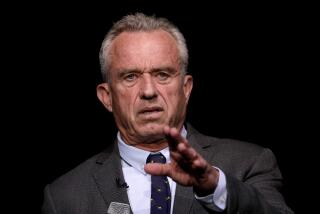Ridge Offers Few Answers on Anthrax
- Share via
WASHINGTON — The new director of homeland security stepped before television cameras Thursday to address mounting public questions about the anthrax scare. But, with little information to impart, he struggled to show himself in command of the situation.
White House officials argued that by frankly acknowledging what he does not know--indeed, what the government does not yet know--Thomas J. Ridge was being upfront and shooting straight.
But Ridge’s sudden encounter with the complex scientific questions at the heart of the anthrax investigation left him to wander awkwardly and seemingly uncomfortably through the important public aspects of his new job.
“Any time you’re dealing with scientific issues where there aren’t any certainties, it’s always a problem,” said Marlin Fitzwater, a veteran of more than two decades in government communications who was White House press secretary for former Presidents Reagan and Bush.
Ridge, Fitzwater added, has not yet gotten on top of that challenge.
Ridge’s briefing did little to resolve the shaky pattern of conflicting assessments and misstatements by government officials since the anthrax threat surfaced.
Last Friday, he said FBI agents had identified the site from which anthrax-laced letters were sent to Senate Majority Leader Tom Daschle (D-S.D.) and NBC News anchor Tom Brokaw. On Monday, a federal law enforcement source said Ridge had spoken “too quickly.”
He also denied reports last Friday that the anthrax had been “weaponized” to make it more virulent or resistant to treatment.
Then Thursday, he dodged the word “weaponized,” saying: “You could put this on the head of a missile, you could put it in an envelope, you could distribute it other ways. So it can--anthrax itself is a weapon.”
He also said last week that the anthrax samples found in Florida, Washington and New York were largely indistinguishable. Thursday he said “that continues to be the case.”
But, he added, subsequent laboratory tests found that the sample taken from Daschle’s office was “pure,” with smaller spores that were more dangerous, and that those mailed to the New York Post were “more coarse and less concentrated.”
Standing next to Ridge, Maj. Gen. John Parker, commanding general of the Army Medical Research and Materiel Command, said a scientist working for him described the New York sample as resembling “Purina Dog Chow--clumpy, like a pellet.”
Ridge was seeking to present the very image of a government chief successfully wrestling with his first crisis--but the facts, or the lack of facts, kept getting in the way.
What is known, he was asked, about where the anthrax powder was produced, how and by whom?
“The tests may or may not lead us to the source,” he said.
Could the anthrax have been produced by an individual in the United States or only by a foreign government?
“Further testing will give us the range. It will either expand it or contract it,” he said. “The testing is incomplete, and we can’t give you the answers to that question yet, if ever.”
A ‘Compulsion to Be Visible’
A Republican political operative with close ties to the White House said Ridge, who left the governorship of Pennsylvania to take the Cabinet-level job, was demonstrating a proper “compulsion . . . to be visible.” But, he added, “sometimes you’re going to have your cart in front of your horse. It will take some time to get into a groove.”
Out of public view, Ridge’s job is just as difficult as his public mission of reassuring an anxious nation: He is working to achieve cooperation among a tangled web of disparate agencies and jurisdictions--the Centers for Disease Control and Prevention, the Federal Emergency Management Agency and the FBI, for example--that are not accustomed to working with each other. And he has no direct authority over them.
“What America needs is a Rudy Giuliani, someone who can get everyone together, crack heads, appear on TV every day. Ridge has to become that guy,” Fitzwater said.
White House communications chief Dan Bartlett defended Ridge, saying he was working in uncharted territory, dealing with such long-range problems as developing a budget for counterterrorism and such immediate needs as helping the U.S. Postal Service come up with emergency funds.
So, when the postmaster general sought $200 million, he turned to Ridge. Ridge asked Budget Director Mitchell E. Daniels Jr., and the money was made available, Bartlett said.
“He has quickly become the focal point in the administration, helping navigate these decisions,” Bartlett added.
More to Read
Sign up for Essential California
The most important California stories and recommendations in your inbox every morning.
You may occasionally receive promotional content from the Los Angeles Times.













